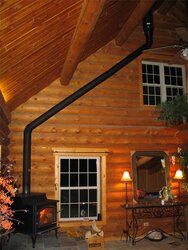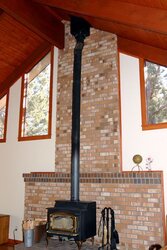Is it not common for chimney fires to occur in the connector pipe? I was just wondering if there would be an issue for folks that top vent into a long lets say 10-15' section of single wall before going into a class a cieling support box.
Chimney Fire in Black Stove Pipe?
- Thread starter southbalto
- Start date
-
Active since 1995, Hearth.com is THE place on the internet for free information and advice about wood stoves, pellet stoves and other energy saving equipment.
We strive to provide opinions, articles, discussions and history related to Hearth Products and in a more general sense, energy issues.
We promote the EFFICIENT, RESPONSIBLE, CLEAN and SAFE use of all fuels, whether renewable or fossil.
You are using an out of date browser. It may not display this or other websites correctly.
You should upgrade or use an alternative browser.
You should upgrade or use an alternative browser.
LLigetfa
Minister of Fire
With a top vent straight up shot, if creosote falls down into the stove, it would likely burn there on top of the baffle. That is a much better place to have burning creosote than say a through-the-wall thimble/Tee.
With the Tee, there is a greater chance that creosote will curl, peel, and fall to collect there for a while before an event sets it off. Creosote falling onto the baffle is more likely to be set off sooner and so will not build up to a large event.
With the Tee, there is a greater chance that creosote will curl, peel, and fall to collect there for a while before an event sets it off. Creosote falling onto the baffle is more likely to be set off sooner and so will not build up to a large event.
firecracker_77
Minister of Fire
This where the double wall is worth a few more bucks for the run before it hits triple. If you do get a fire, it should be able to withstand a fire longer before failure.
greenteam said:most stoves list the maximum length of connector pipe usually less that 6' or code limits to being a short length. I know of no incidents connector pipe is anywhere near 15'
"
Attachments
greenteam said:from your manual...tHE MAXIMUM VERTICAL RUN OF SINGLE WALL STOVEPIPE SHOULD NOT
EXCEED 10 FT.
The recommended limitation applies to Single Wall stovepipe. I've never heard of a similar limitation on Double Wall. In any case, if you burn proper fuel and operate the appliance the way it's designed to be operated, and properly maintain (clean) the system, you really shouldn't ever have a chimney fire, because your flue will remain relatively free of excessive creosote build-up. Rick
LLigetfa
Minister of Fire
Eh BB. The general thinking is that the angle of repose for creosote is 30° off plumb and as such class A elbows may not exceed 30°. That pic looks to be about 45° and I would not be comfortable with it. I am not stating it as a code requirement, just my personal comfort factor.BrotherBart said:greenteam said:most stoves list the maximum length of connector pipe usually less that 6' or code limits to being a short length. I know of no incidents connector pipe is anywhere near 15'
"
LLigetfa said:"Eh BB. The general thinking is that the angle of repose for creosote is 30° off plumb and as such class A elbows may not exceed 30°. That pic looks to be about 45° and I would not be comfortable with it. I am not stating it as a code requirement, just my personal comfort factor.
I think that long pipe is insane for more reasons than one.
The big problem I have with the one in the pic I posted is support at those angles. Just looks scary to me.
BrotherBart said:The big problem I have with the one in the pic I posted is support at those angles. Just looks scary to me.
Agreed...I don't like it much either...for that same reason. Rick
sir james
Member
Wonder how close that pipe is to the wall?BrotherBart said:The big problem I have with the one in the pic I posted is support at those angles. Just looks scary to me.
LLigetfa
Minister of Fire
As the air around a vertical pipe heats, it continues to rise upward along the pipe as hot air so the losses diminish. The angled pipe would have greater losses because the hot air would not follow the pipe.
HotCoals
Minister of Fire
WOW..never seen anything like it!BrotherBart said:greenteam said:most stoves list the maximum length of connector pipe usually less that 6' or code limits to being a short length. I know of no incidents connector pipe is anywhere near 15'
"
Hass
Minister of Fire
LLigetfa said:As the air around a vertical pipe heats, it continues to rise upward along the pipe as hot air so the losses diminish. The angled pipe would have greater losses because the hot air would not follow the pipe.
A lot of people who are trying to "be the most efficient" run their stove pipe like that. look on youtube for videos of it... TONS of them. Of people running through a foot from their ceiling through their house, attach on a couple of magic heats... because the chimney is "where all your heat waste is". So I think people do it on purpose thinking they're doing a good thing.
Hell, my chimney goes straight up, and is only 16' total using 4.5' of double wall in the house (included in the 16')... and I get icicles hanging off my cap when it's cold -.-
If I had some single run like that, my flue gas would be room temp by the time it got outside.
LLigetfa
Minister of Fire
Ja, I know it. In the old days we would start with 8" pipe so that we could capture more heat cuz the flue gases moved slower. As the pipe snaked around, we would reduce to 7" using a long taper to keep the velocity up as the gasses cooled, then reduce again to 6" at the thimble. The pipe would hang from eye bolts in the ceiling with snare wire.Hass said:A lot of people who are trying to "be the most efficient" run their stove pipe like that...
coverdome
Member
I'm planning an install with Selkirk 8"dbl wall black pipe. They recommend not to exceed 20' dbl wall before going into to class "a".
My install was going to be a straight run of 27' dbl wall to cathedral ceiling. Their customer service said that length should be ok on straight run,
provided the pipe was stabalized somewhere in the run.
My install was going to be a straight run of 27' dbl wall to cathedral ceiling. Their customer service said that length should be ok on straight run,
provided the pipe was stabalized somewhere in the run.
woodjack
Minister of Fire
Same thing jumped out at me. That's a lot of hot pipe not to be supported.BrotherBart said:The big problem I have with the one in the pic I posted is support at those angles. Just looks scary to me.
Maringotka
New Member
In the old days we would start with 8" pipe so that we could capture more heat cuz the flue gases moved slower. As the pipe snaked around, we would reduce to 7" using a long taper to keep the velocity up as the gasses cooled, then reduce again to 6" at the thimble.Same thing jumped out at me. That's a lot of hot pipe not to be supported.
I understand from this post that reducing the diameter of the pipe causes the flu gas to move through the pipe faster. I’m wondering if the possibility of creosote buildup would be less if the chimney was a smaller diameter pipe than the stove pipe?
Similar threads
- Replies
- 8
- Views
- 440
- Replies
- 4
- Views
- 518
- Replies
- 39
- Views
- 2K
- Replies
- 0
- Views
- 363



